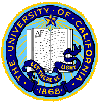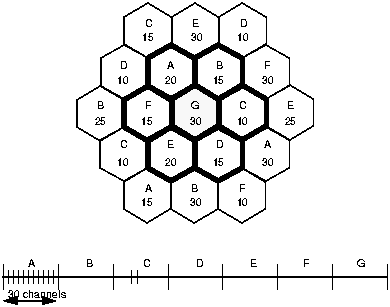 |
Scott Jordan | |
|
|

Our focus in this work is dynamic channel allocation in cellular networks. Many DCA algorithms have been proposed in the literature. However, they are often based on heuristics, and optimal policies are rarely considered. Our goal here is to present a framework within which DCA policies can be presented and evaluated.
In the first paper, we suggest a categorization of DCA policies on the basis how the policy determines connection access control, channel assignment, and channel reassignment. We hope that this categorization will help distill the concepts involved and encourage the research that is necessary to extend these concepts to future integrated service wireless systems.
Resource Allocation in Wireless Networks, Journal of High Speed Networks, vol. 5, no. 1, 1996, pp. 23-34.
In the second paper, we suggest that the optimal DCA policy varies from maximum packing at low loads to fixed allocation at high loads. This policy is often impractical to implement, but can be considered as a performance bound on practical systems.
A Performance Bound on Dynamic Channel Allocation in Cellular Systems: Equal Load (with A. Khan), IEEE Transactions on Vehicular Technology, vol. 43 no. 3, April 1994, pp. 333-344.
In the third paper, we introduce two worst-base performance metrics. We prove a lower bound on any DCA policy, and demonstrate the tradeoff between the performance and the complexity of a channel allocation policy.
Worst-Case Performance of Cellular Channel Assignment Policies (with E. Schwabe.), ACM Journal of Wireless Networks, vol. 2, 1996, pp. 265-275.
In the final paper, we consider DCA in interference-limited systems such as CDMA. We focus on the relationship between system performance and the amount of imbalance in load among neighboring cells. We find that with use of C/I information, the difference in performance between FCA and DCA (in terms of throughput or blocking probability) is increasing with load imbalance.
Dynamic Channel Allocation in Interference-Limited Cellular Systems with Uneven Traffic Distribution, (with Y. Argyropoulos, S. Kumar) IEEE Transactions on Vehicular Technology, vol. 48 no. 1, January 1999, pp. 224-232.
Portions of this work were supported by NSF. Any opinions, findings, conclusions or recommendations expressed in this material are those of the author(s) and do not necessarily reflect the views of the National Science Foundation or IEEE. This material is presented to ensure timely dissemination of scholarly and technical work. Copyright and all rights therein are retained by authors or by other copyright holders. All persons copying this information are expected to adhere to the terms and constraints invoked by each author's copyright. One print or electronic copy may be made for personal use only. Permission must be obtained from the copyright holder for systematic or multiple reproduction, distribution to multiple locations via electronic or other means, duplication of any material in these papers for a fee or for commercial purposes, modification of the content of these papers, reprinting or republishing of this material for advertising or promotional purposes or for creating new collective works for resale or redistribution to servers or lists, and to reuse any copyrighted component of this work in other works.